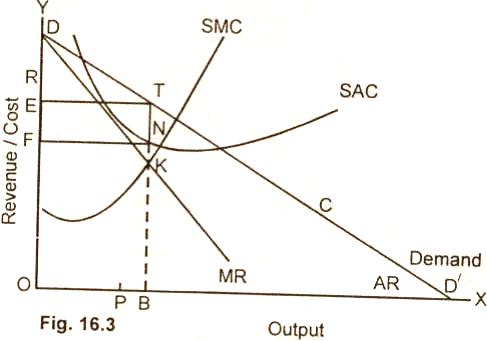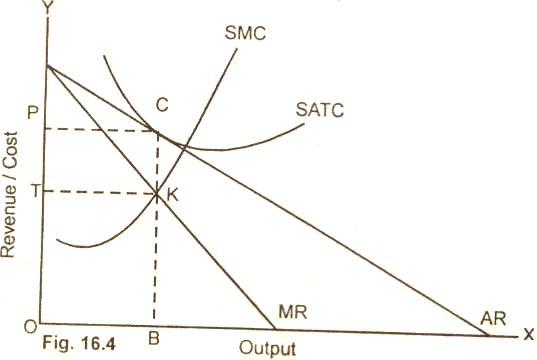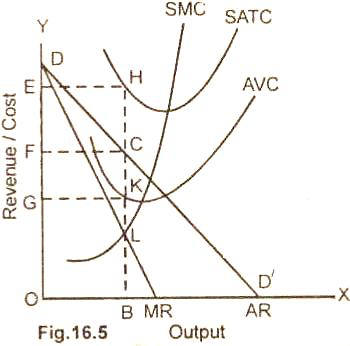Short Run Equilibrium Price and Output
Under Monopoly:
Short
Run Equilibrium of the Monopoly Firm:
In the
short period, the
monopolist behaves like any other firm. A monopolist will
maximize profit or minimize losses by producing that output for which marginal
cost (MC) equals marginal revenue (MR). Whether a profit or loss is made or not
depends upon the relation between price and
average total cost (ATC). It may be made clear here that a monopolist does not
necessarily makes profit. He may earn super profit or normal profit or even
produce at a loss in the short ran.
Conditions for the Equilibrium of a Monopoly Firm:
There are
two basic conditions for the equilibrium of the monopoly firm.
First
Order Condition: MC = MR.
Second
Order Condition: MC curve cuts MR curve from below.
Explanation:
(a)
Short Run Monopoly Equilibrium With Positive Profit:
In the short period, if
the demand for the product is high, a monopolist increase the price and the
quantity of output. He can increase the, output by hiring more labor, using more
raw material, increasing working hours etc. However, he cannot change his fixed
plant and equipment. In case, the demand for the product falls, he then
decreases the use of variable inputs, (like labor, material etc.).
As regards
the price, the monopolist is a price maker. There is a greater tendency for the
monopolist to have a price which earns positive profits. This can only be
possible if the price (AR) is higher than average total cost (ATC). The short
run profit earned by the monopolist is now explained with the help of the
diagram (16.3) below.
Diagram/Curve:

In this
diagram, the monopoly firm is in equilibrium at point K where SMC = MR. The
short run marginal cost (SMC) curve cuts MR from below. At point K both the
equilibrium conditions are fulfilled. As a result, therefore, OE is monopoly
price and OB, the monopoly
output. At the monopoly output OB, the average total cost OF = BN. The profit
per unit is FE. The short run monopoly profit is ETNF, It is represented
by the area of shaded rectangle in figure 16.3.
At the
output smaller than OB (say at point P) MR > SMC. Therefore, increased output up
to B adds more to total receipts than to total costs. In case, the output is
increased beyond OB, the MR < SMC. Hence, the increased outputs beyond OB adds
more to total cost than to total receipts. This causes profits to decrease. So
the best level of output for the monopolist firm is that where SMC curve cuts
the MC curve from below.
(b)
Short Run Equilibrium With Normal Profit Under Monopoly:
There is a false impression regarding the powers of a monopolist. It is said
that the monopolistic entrepreneur always earns profits. The fact, however, is
that there is no guarantee for the monopolist to earn profit in the short run.
If a monopolist firm produces a new commodity and attempts to change the taste
pattern of the consumers through advertising campaigns etc., then the firm may
operate at normal profit or even produce at a loss minimizing price in the short
run (Covering variable cost only). The normal profit short run equilibrium of
the monopoly firm is explained, in brief, with the help of the diagrams.

In figure
(16.4), a firm is in the short run equilibrium at point K, where SMC = MR. The
price line is tangent to SAC at point C. The firm charges CB price per unit for
units of output OB. The total revenue of the firm is equal to the area OPCB. The
total cost of the firm is also equal to the area OPCB. The firm earns only
normal profits and continues operating.
(c) Short Run Equilibrium With Losses Under Monopoly:
A monopolist also accepts short run losses provided the variable costs of the
firm are fully covered. The loss minimizing short run equilibrium analysis is
presented graphically.

In this
figure (16.5), the best short run level of output is OB units which is given by
the point L where MC = MR. A monopolist sells OB units of output at price CB.
The total revenue of the firm is equal to OBCF. The total cost of producing OB
units is OBHE. The monopoly
firm suffers a net loss equal to the area FCHE. If the firm ceases production,
it then has to bear to total fixed cost equal to GKHE. The firm in the short run
prefers to operate and reduces its losses to FCHE only. In the long, if the loss
continues, the firm shall have to close down.
Relevant Articles:
|